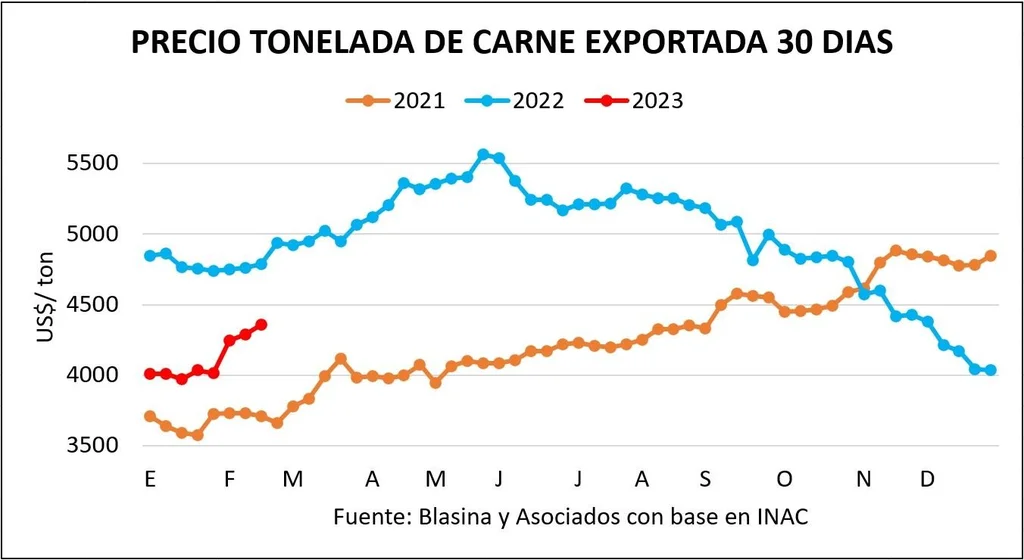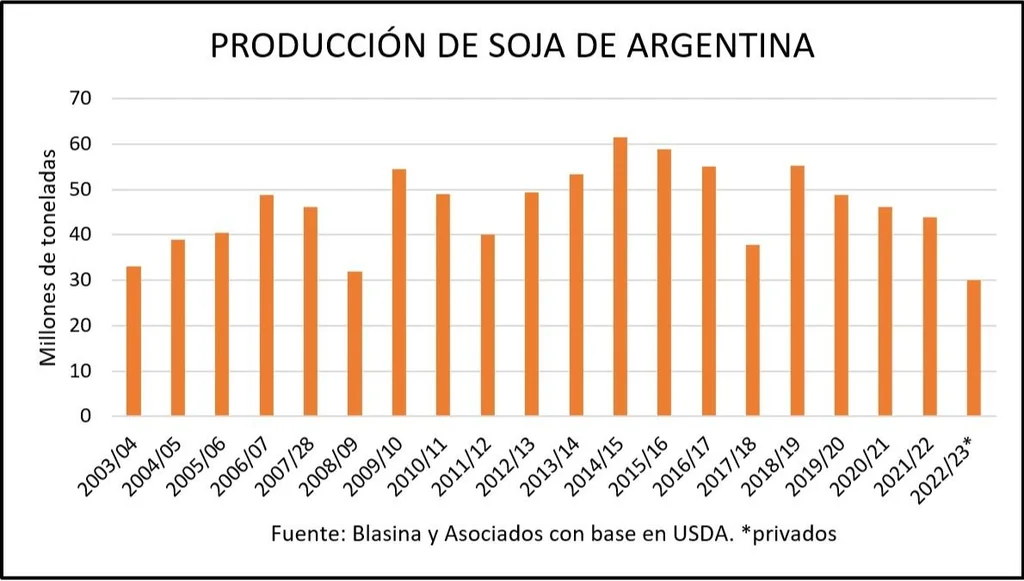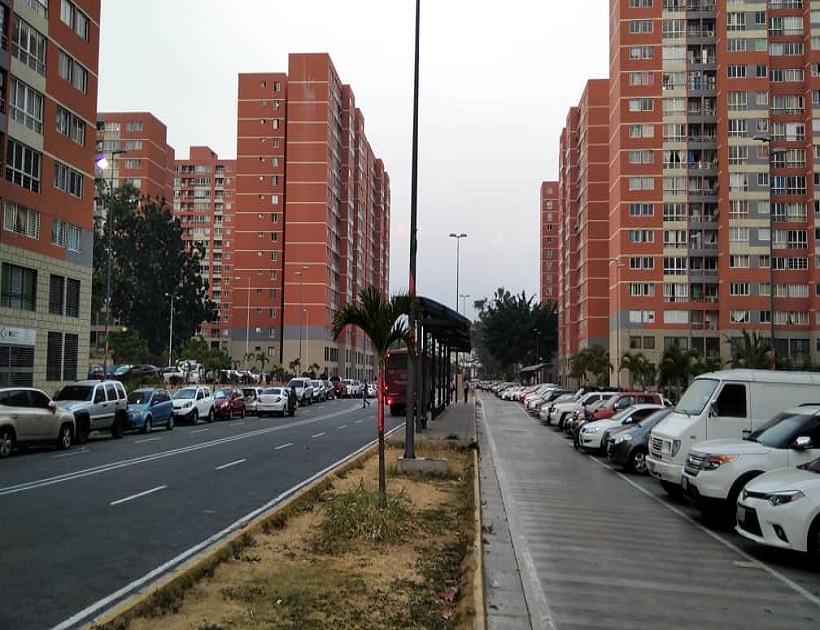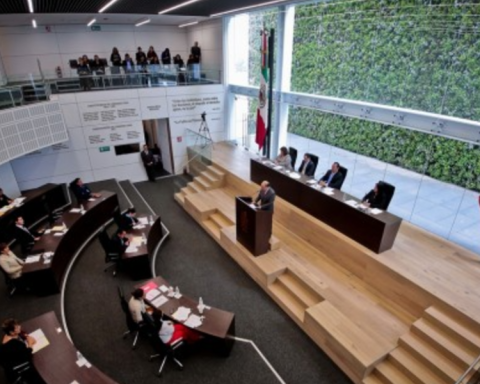The price of the property is affirmedwhich returns to values of September 2022, although Concern grows over livestock availability. Crop deterioration supports soybean price and pushes up cornwhile wool seems to have bottomed out in its third week of declinewith a small rise on the last day of operations.
cattle rally
March began with a price rally that brought the best steers to US$4 per kilo. In one month the price climbed almost 60 cents on the dollar. Little supply and an export price that continues to gradually rise underpin a market that is toning.
Businesses for quality heavy steers are made for US$3.90 per kilo in fourth scale and between US$3.60 and US$3.65 for cows. Top deals reach US$4 for the steer and over US$3.70 for the cow, said Otto Fernández Nystrom, a member of the Cattle Shippers Association.
The barrier of US$ 4 has been overcome in specific cases, in exceptional cattle and volume business, commented Gustavo Basso, director of Gustavo Basso Negocios Rurales.
Markets in agribusiness
The improvement in values stimulated the departure of cattle that were waiting for price. With rains that have been irregular and insufficient, doubts are placed on the availability of cattle supply going forward. One of the great challenges will be to cross the winter, hard in terms of production, with a supply that would grow from autumn onwards, pressured by the forage situation, and that would decrease in spring, Basso estimated.
On the industry side, demand is active and entries are short. In China, the first reactions to the closure of exports from Brazil were prudent, waiting for how and how long the matter will be resolved. This Thursday at the last minute it was confirmed that the case of mad cow registered in Brazil was “atypical” and not due to consuming an infected ration, according to the results of a Canadian reference laboratory, where samples were sent. The expectation is that the period in which Brazil is out of the game will be brief.
This sanitary problem brought down the steer in the neighboring country, which this week was 15% below the local steer, with an average of US$ 3.48 per kilo, according to data published by the CEPEA institute of the University of San Pablo.
In Europe, the Hilton maintains its firmness and in Uruguay, US$4,000 per ton seems to be the new export price floor for beef. Last week the value was US$4,710, almost US$500 above the previous week. The average for the last 30 days increased for the third consecutive week and stood at US$4,356, according to preliminary data from the National Meat Institute (INAC).

Markets in agribusiness
The year seems to go from less to more. The latest report from the Dutch bank Rabobank, published this week, projects that Chinese demand for beef will grow in the second half of the year and with it world prices for that product will increase.
The external signals have stimulated the activity of the refrigerators. Minerva and Marfrig had already anticipated last week that they would supply the demand of their Chinese customers from their plants in Argentina and Uruguay.
With little supply of well-prepared property, the local work fell on the week of carnival and has been supported in large part by free-range cattle. The latest data from INAC was 46,055 cattle, with a lower volume of females. At the end of the week, a union conflict arose in the Colonia refrigerator linked to salary negotiations, which is expected to be resolved next week.
In the replacement market, the drought factor has made itself felt and was reflected in the rhythm of demand and in values, with drops for all categories in the last grid of the Association of Livestock Shippers (ACG).. Also in virtual auctions this week, with adjustments in practically all categories. The calves averaged US$ 2.38 in Lot 21 this Thursday and US$ 2.52 in Plaza Rural special Angus, this Friday. The live export plays its part by putting a floor for the calves.
The market for sheep remains in demand, with gradual increases that occur week by week, at a slower rate than in cattle. Heavy lambs are priced at US$3.30 per kilo, capons US$3 and ewes US$2.85.
In sheep meat, the volume exported recovers, but not the prices. Last week the average exported ton was US$3,781, in line with the average US$3,780 in the accumulated of 2023, 27% below in the year-on-year comparison.
Crops: dramatic situation
The week had two very different parts. It started low and ended up, which makes the balance relatively neutral. The worsening of the drought in Argentina and Uruguay made soybeans regain momentum, which on Wednesday had marked its lowest prices since January due to the few purchases by China in the United States and the weight of the Brazilian harvest, which, even with some cuts, will be above 150 million tons and will therefore be a record.
In the case of wheat, what has moved the market is doubts about renewing a Black Sea grain export deal after Russia said the West was burying the deal.
In Uruguay the panorama is dramatic. Crops are dying and are being chopped, baled, or in some cases opened up for cattle to eat what they can. There will be a large reduction in the harvest area and the yields will hardly cover the costs. Particularly in the case of corn, this will have strong repercussions on livestock and dairy by generating a sharp increase in production costs. The usual supplier of corn to Uruguay, Argentina, is also in a situation of free fall in the state of the crops and will have a very low exportable balance.

Markets in agribusiness
Prices had slight downward corrections in soybeans, above US$ 540 per tonwhile the price of corn rises above US$ 320 to raise from the farm. Wheat remains unchanged, above US$ 290 per ton.
As the weather hits, measures to deal with climate change generate resistance. Brussels witnessed this Friday protests by producers against restrictions on the use of nitrogen.
Local police estimated the number of tractors clogging the streets of Brussels at 2,700. Many were decorated with large plaques reflecting the wrath of the farmers. “Proud to be a farmer,” said one of those signs.
“The nitrogen deal as it stands now will cause socio-economic carnage,” the farm organizations said in a joint statement, adding that they want the deal to better reflect future prospects for the agricultural sector.
“We are all convinced that something has to change regarding nitrogen, but the agricultural sector should not be treated differently from the industrial sector,” said protester Leen Engelen, referring to one of the disputed points in the bill.
On the other hand, Brazil announced the approval for sowing and importation of the HB4 drought-tolerant transgenic cereal developed by the Argentine firm Bioceres. It is the first approval for the consumption of a transgenic wheat.
Lana: from less to more
Wool price, which has rallied strongly for eight weeks, posted its third week of decline, though appears to have bottomed out.
The Eastern Markets Indicator (IME) closed this week almost 1% below the previous week, although the week went from less to more. It fell from US$ 9.32 per clean base kilo to US$ 9.20 on Tuesday, remained stable on Wednesday and rose to US$ 9.23 on Thursday. The Australian dollar weakened and gave firmness to the prices in local currency -the indicator rose compared to the previous week- and gave fluidity to commercial operations.

Markets in agribusiness
February 2023 was the month with the highest supply volume in the last 11 months with 193,855 bales and, in turn, it was the month of February with the highest supply since 2016.
The months of January and February had an important component of cross-breed wool, 25% of the volume, an increase of 21% in relation to previous months, according to the weekly report of the Uruguayan Wool Secretariat (SUL).
In the local market, operations are punctual and focused on fine woolswith values around US$5.2 per dirty base kilo for 20.8-micron Merino batches, US$4.8 per kilo for 21.5-micron wool and US$3.8 for 23-micron wool. .


















